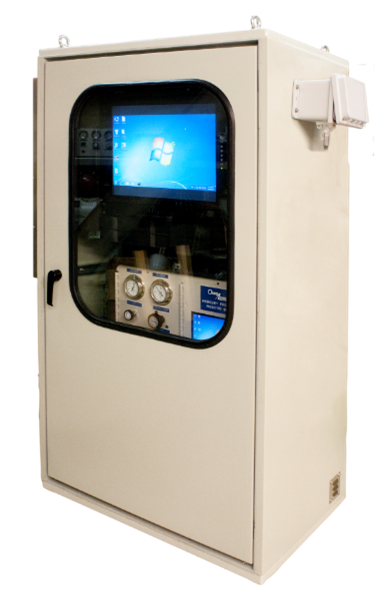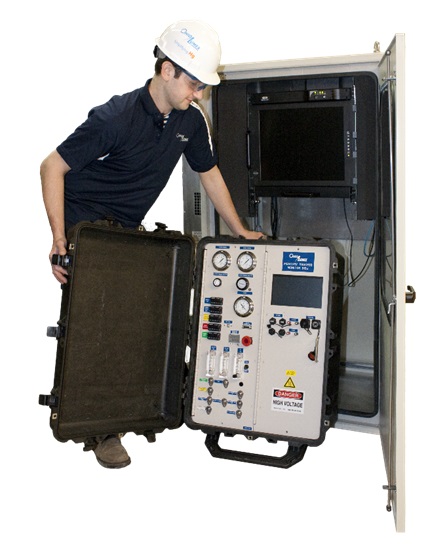A real-time time monitor is an essential tool for understanding and controlling your mercury emissions as well as optimizing mercury control technologies. For this reason, Ohio Lumex has created the 915J Mercury Process Monitor. It is designed to perform Continuous Emissions Mercury Monitoring for Point Source Emissions (Stacks) derived from combustion of coal, Portland cement manufacturing, industrial boilers, municipal incinerators, and more. Over 10 years of research and development, extensive testing, and improvements have resulted in an innovative design that focuses on accuracy, high reliability, low maintenance, ruggedness, ease of use, and flexibility. The industry-leading performance of the system has been demonstrated at more than one hundred plants under a variety of challenging conditions and results have been presented at conferences as well as published in papers and magazines.

Among the features that make the 915J Hg Process Monitor unique in the industry is the ability to place all of the equipment in close proximity to the monitoring location and thus significantly reduce the length of umbilical lines from the testing port to the monitor. The self-contained temperature controlled NEMA 4X enclosure allows for this flexibility and greatly reduces the plant’s up-front capital expenditures. In addition to significant installation cost savings, short umbilical lines also minimize Hg sample loss, improve system calibration, and reduce future maintenance/operating expenses.

We understand that long term maintenance and support considerations are vitally important and have designed the 915J Process Monitor with this in mind. Features such as remote monitoring and troubleshooting capabilities, infrequent and easy replacement of consumables (quarterly is typical, depending on flue gas conditions), and modular design all contribute to a sensible user experience. Instead of waiting days or even weeks for a technician to come on site, diagnose the problem, order parts, and service an instrument, the 915J Control Module is designed to be easily disconnected and brought down to your shop or packed and shipped for service. To minimize downtime and maintain data availability, Ohio Lumex can overnight an alternate control module to the plant for temporary use while the other unit is undergoing maintenance. Of course, a certified Ohio Lumex field engineer can also come on-site to service the monitor as these instruments are a priority for our service department. The flexibility in these options allows Ohio Lumex to offer exceptional customer service and maintain excellent data availability for its instruments. To date, Ohio Lumex continuous mercury monitors have more than 3,650,000 operating hours with 98% data availability. Furthermore, the quality of the data is backed up by over ten years of simultaneous sorbent trap validation.
Specifically for the cement industry, no typical mercury CEM will do. The CEMs used for the cement industry must be able to handle wide swings in mercury concentration depending on if the in-line raw mill is on or off. No other mercury monitor in the world can handle dramatic swings like the 915J. This is due to the customized dilution system and custom-built adjustable high span calibrator specifically designed for the cement industry. Further, Speciation might be necessary depending on the type of mercury control in use to reduce mercury emissions, especially if ACI or brominated PAC is chosen. The 915J has proven to have unbiased results with halogen injection and brominated carbons. Many other mercury CEMs struggle with this as their data show biased low mercury readings when halogen injection is incorporated into the mercury control strategy. Issues can also arise during kiln startups with #2 fuel oil or when burning tire fluff or other fuels that cause soot buildup in the probe or on the filters. However, the 915J is able to overcome this challenge since it can be automatically controlled by the plants’ DAHS to start sampling when kiln feed is on.
Key Features of the 915J
- Spectrometer: The 915J features a highly sensitive atomic absorption spectrometer with Zeeman background correction providing interference free measurements.
- The Probe/Filter: Hastelloy heated probe. Sampling is based on high velocity extraction, filtering, and dilution. System uses plant air, thus eliminating the need for any mechanical pumps. Critical orifice provides precise sample dilution. The probe and filter are self-cleaning based on periodic blowback eliminating the “reactive ash” Hg scrubbing effect.
- Speciation: Measures Total Hg or only Elemental Hg when in speciation mode.
- Calibration: Built in Elemental Hg calibrator with low span (2-5 ug/m³) or custom-built adjustable high span calibrator (as high as 70ug/m³). No other calibration source required.
- Umbilical Lines: 30ft standard length (other sizes available).
- Data Acquisition/Communications: Built-in industrial grade computer, real time readings with Excel data file or direct communications with DAHS via Modbus TCP. On-Line remote data transfer and analyzer control/calibration capabilities. Communication can also be done via 4-20mA signal with an optional PLC.
- Utility Requirements: Power: 3 110/220 volt lines set for 20 amp Breakers, 2000 watts total. Instrument quality air (ISO8573-1:2010 Class 3 or better), 90 psi of pressure minimum, 2 SCFM minimum.
We have worked through this process with many plants and are eager to work with you!
Please contact Alexandra for a quote or a detailed presentation.

